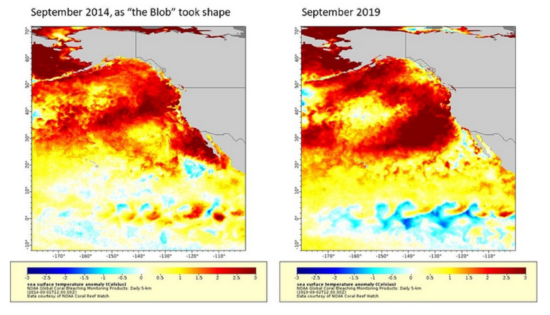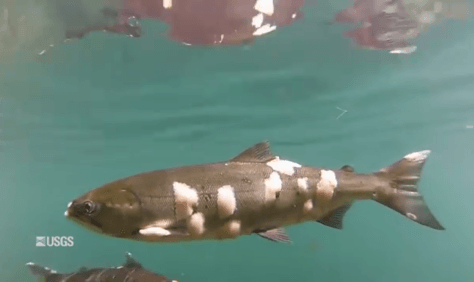
NOAA Warning Of New Blob Off Northwest Coast
Federal oceanographers say a new Blob has formed in the North Pacific off the Northwest Coast in recent months and is already second in size to the one earlier this decade that hit salmon and other marine life hard, led to a nearly snowless winter in parts of the region and elevated summer temperatures.

“It’s on a trajectory to be as strong as the prior event,” said Andrew Leising, a research scientist at the National Oceanic and Atmospheric Administration’s Southwest Fisheries Science Center in California in a story out ahead of a press call at noon. “Already, on its own, it is one of the most significant events that we’ve seen.”
Researchers are monitoring the new marine heatwave’s development and say that despite typical coastal upwellings that keep nearshore waters cooler in summer, warm water appears to have moved onshore to the Washington Coast.
Westport and Ilwaco anglers have reported catching numerous more southerly species, including yellowtail, bluefin and mahi mahi, and last week a 7-plus-foot-long striped marlin was caught off Garibaldi, on Oregon’s North Coast.
According to the Southwest Fisheries Science Center, that species of marlin is usually only seen as far north as Southern California‘s Channel Islands.

Still, there is some uncertainty in how bad this new blob might get. NOAA says it’s still early and it could break up or moderate as fall cools.
“It looks bad, but it could also go away pretty quickly if the unusually persistent weather patterns that caused it change,” said Nate Mantua, a federal research scientist formerly with the University of Washington.
UW atmospheric scientist Cliff Mass called it “a junior Blob” on his blog yesterday for how relatively recently it has formed. He notes the variance from normal sea surface temperatures is up to 7.2 degrees Fahrenheit, among “some of the most unusually warm water across the planet” at this moment.
Only portions of the west coast of Greenland and Arctic nearshore areas compare.
The 2014-15 blob was the largest marine heatwave in 40 years, according to the feds, and this new one is “almost the same size.”
The winter of 2014-15 saw rain in the Northwest’s mountains, leading to a snow drought that by summer had fishery managers restricting angling to protect fish in record-low, warm streams.
2015’s Puget Sound pinks and coho came in small and starving because of how bad ocean feeding conditions were for them, but 2019’s pinks have been good sized. It’s likely the former year-class were exposed for a longer period to the original blob than the latter fish to the new one.
NOAA’s story continues, saying:
A key question is whether the new heatwave will last long enough to affect the marine ecosystem. Biologists say that its large size means it probably already has. For example, warmer conditions during “the Blob” left lesser-quality food available to young salmon entering the ocean. It also shifted predator distributions in ways that contributed to low returns of salmon.
Other impacts linked to the earlier heatwave include:
- The largest harmful algal bloom recorded on the West Coast, which shut down crabbing and clamming for months.
- Thousands of young California sea lions stranding on beaches.
- Multiple declared fishery disasters.
NOAA Fisheries scientists recently convened a special meeting to discuss the emerging heatwave and how to anticipate and track its effects. They are now reviewing impacts documented during the “the Blob” to compare them against the effects of the emerging heatwave.
“Given the magnitude of what we saw last time, we want to know if this evolves on a similar path,” said Chris Harvey, a research scientist at the Northwest Fisheries Science Center.
